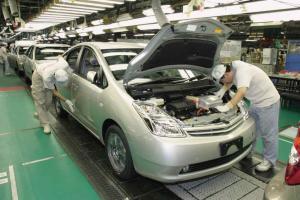J@pan Inc -- Toyota as Number One
Continuous improvement is key to success.
By Arjen van Blokland
Amidst growing fears that General Motors, the world's largest car manufacturer, will go bust, Toyota Motor Company is rapidly expanding and on course to surpass GM in production this year. Toyota consistently out-performs competitors in quality, productivity, cost reduction, sales growth, and market capitalization. Toyota sold 7.4 million vehicles worldwide in 2005, 30 percent more than in 2001. Its phenomenal success is attributable to the Toyota Production System, a corporate culture that fosters learning, and Science Statistical Quality Control.
The Toyota Production System
In comparison with American and European automakers, Toyota was late developing new markets. More than 70 percent of its production remains domestic, although the Japanese market accounts for only 32 percent of the company's global passenger car sales. This is going to change, however. Toyota is aggressively adding production capacity in North America and Asia. It is, for example, building a new plant in San Antonio, Texas, which will boost its production capacity by 200,000 units. Even more impressive is the planned production growth in Asia - total of half a million units in China and Thailand by 2007.
 Prius, Toyota's hybrid vehicle, on the line at the Aichi Plant.
Prius, Toyota's hybrid vehicle, on the line at the Aichi Plant.
A pillar of Toyota's success is the Toyota Production System (TPS). Toyota's high-quality production is customer focused. This means that no one should manufacture a product or provide a service until someone downstream asks for it. This so-called pull production prevents overproduction and inventory build-up.
TPS was introduced by Taiichi Ono (1912-90) after World War II. Ford and GM relied on mass production. But in the postwar era the situation in Japan was entirely different from that in the United States. American automakers could exploit economies of scale and large production lines with big equipment to churn out cars at low cost. In contrast, Toyota had to operate with limited resources in a small market in a country recovering from the ashes of war. Ono concluded that mass production was not applicable to Toyota. So he introduced flexible production lines and operations with short lead times. Toyota does not make cars in batches. Instead, different car models are assembled one after another on the same line. So personnel must be flexible and machinery tools easy to change.
In his book Toyota Production System (Productivity Press, 1988) Ono writes: "All we are doing is looking at the time line from the moment the customer gives us an order to the point when we collect the cash. And we are reducing that time line by removing the non-value-added wastes."
Toyota first ventured overseas when it formed a joint venture with GM in the 1980s. Toyota took over a truck plant in Fremont, California, that had been closed by GM. The Japanese automaker introduced TPS. When the factory reopened, it surpassed all of GM's American plants in quality and productivity. Noteworthy was that Toyota achieved this with almost the same unionized work force GM had employed. Toyota succeeded in building bonds of trust with employees. Even when the plant was running far below capacity, no workers were laid off.
Toyota has developed a corporate culture in which employees learn better and faster and receive a more comprehensive education than their competitors. It is a truly learning organization that continuously improves not only its work but also its management processes. GM has introduced its own Toyota-like production system with all the tools and methods, but failed to foster a culture rooted in a capacity to learn and improve. Back in the '80s GM lost a golden opportunity in the Golden State, where Toyota had carried out a virtual case study in TPS implementation and how to nurture such a culture.
Science Statistical Quality Control
In recent years, Toyota has adopted a new quality control principle. It expands the scope of quality control from the production line on the lower stream to include development and design on the upper stream. In other words, it includes marketing, sales and corporate support functions. Accordingly, the concept of quality was reoriented from product quality to business process quality. The new method, called Science Statistical Quality Control (Science SQC), is the brainchild of Kakuro Amasaka, a professor at Aoyama Gakuin in Tokyo and the former head of Toyota's Total Quality Management Promotion Division. Science SQC is a method to identify cause-and-effect correlations between seemingly unrelated facts. It effectively utilizes the experience and know-how scattered across different levels, divisions and people within Toyota and its group suppliers.
Amasaka describes the method in his book Science SQC, New Quality Control Principle (Springer-Verlag Tokyo 2004). The book not only gives the theoretical background of Science SQC but also demonstrates its effectiveness using practical examples.
It recounts in detail success stories from product development using Science SQC, such as determining the cause of an oil leak, which led to a change in the design of the oil seal. Science SQC does not focus on design and manufacturing only. Recently Amasaka has applied the method to improving conditions or older workers at plants. Science SQC is also applicable to other companies and industries. Amasaka is promoting the method through the Amasaka Forum, whose participants study ways other manufacturers can adapt the method.
It remains to be seen whether overseas companies can avail themselves of SQC. If TPS is any example, perhaps they can't. JI
Arjen van Blokland writes the online magazine's "Wireless Watch" newsletter.
Contact: arjen@class.co.jp
Science SQC, New Quality Control Principle: The Quality Strategy of Toyota
By Kakuro Amasaka
Springer-Verlag Tokyo. 2004:
317 pages, hard cover
orders@svt-ebs.co.jp





